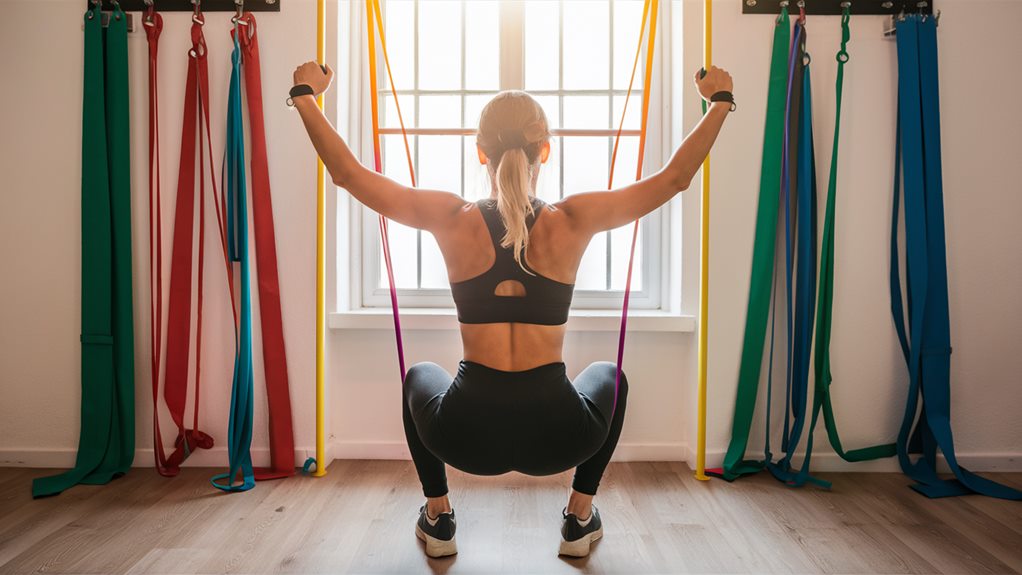To use resistance bands effectively at home, start by choosing the right band based on your fitness level and goals. Focus on your form; maintain core engagement and control throughout each movement. Incorporate exercises targeting various muscle groups, like squats and bicep curls, and use bands for dynamic stretches during warm-ups. Avoid common mistakes such as using bands that are too lightweight or heavy. Progress your workouts gradually to keep challenging yourself, and stay motivated by tracking your improvements. You'll discover more tips and tricks that can elevate your training even further!
Key Takeaways
- Choose the right resistance band based on your fitness level and desired muscle engagement to maximize effectiveness.
- Incorporate bands into warm-ups and combine them with bodyweight exercises for a well-rounded routine.
- Maintain proper form and control during exercises to prevent injury and enhance muscle activation.
- Gradually increase resistance and vary your workouts to keep your routine challenging and engaging.
- Monitor your progress regularly to adjust your training and stay motivated towards achieving your fitness goals.
Choosing the Right Resistance Band

When you're ready to elevate your home workouts, selecting the appropriate resistance band can make all the difference. With so many options out there, understanding resistance levels and material types is crucial to finding the perfect fit for your fitness journey. Many resistance band sets offer versatile options that cater to various resistance levels, ensuring that you can discover the ideal band for your current fitness level.
First, consider the resistance levels. Bands typically come in light, medium, heavy, and extra heavy choices. If you're just starting, a light or medium band might be optimal, as it allows you to build strength gradually without risking injury. As you progress, you can introduce heavier bands to challenge your muscles further. Remember, it's not about how heavy the band is, but how effectively you can activate your muscles.
Next, think about the material types. Most resistance bands are crafted from latex, fabric, or rubber. Latex bands are favored for their durability and elasticity, enabling a wide range of exercises. However, if you're sensitive to latex, consider fabric bands, which are often gentler and more comfortable against your skin. They can provide excellent resistance as well, particularly for lower body workouts.
Selecting the right resistance band is about discovering what feels most suitable for you. Don't hesitate to experiment with different types and resistance levels until you find what truly connects with your body. By making this decision, you're not just acquiring a piece of equipment; you're investing in your health and fitness community. Let's get stronger together, one band at a time!
Proper Technique for Exercises
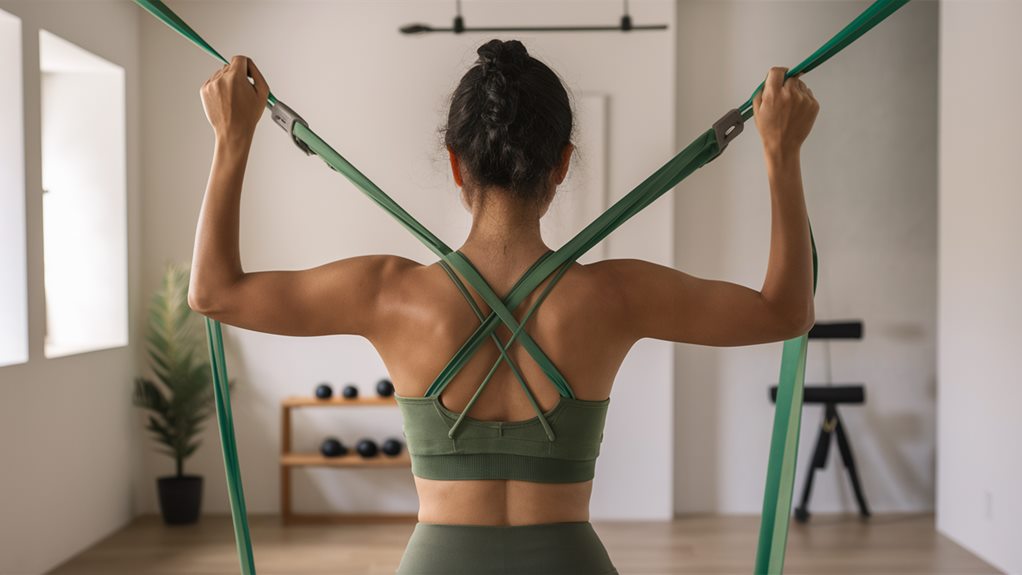
Mastering proper method for exercises with resistance bands is important for maximizing your results and reducing the risk of injury. Start by ensuring your body alignment is correct. Stand tall, engage your core, and keep your shoulders relaxed. This foundation allows you to perform exercises effectively and safely. Using high-quality materials in your equipment, like organic cotton in eco-friendly wraps, can also improve your overall workout experience.
Next, focus on your movements. When you pull or push the band, maintain a controlled pace. Avoid jerking or using momentum; instead, think about each muscle group you're working. This mindfulness not only improves your workout but also builds a deeper connection with your body.
Breathing control plays a pivotal role in your performance. Inhale as you prepare for the movement, and exhale as you exert force against the band. This rhythmic breathing helps you maintain energy and focus while ensuring your muscles receive adequate oxygen.
Don't forget to listen to your body. If you feel any discomfort or strain, reassess your form or adjust the resistance of the band. It's normal to feel challenged, but pain is a sign to pause and evaluate.
Lastly, remember that consistency is key. Incorporate these techniques into your routine, and you'll start noticing improvements in your strength and stability. Engaging in this journey together with others can foster a sense of community. Share your experiences, support one another, and celebrate each other's progress. You're not alone in this; you're part of a motivated group working towards better health.
Targeting Different Muscle Groups
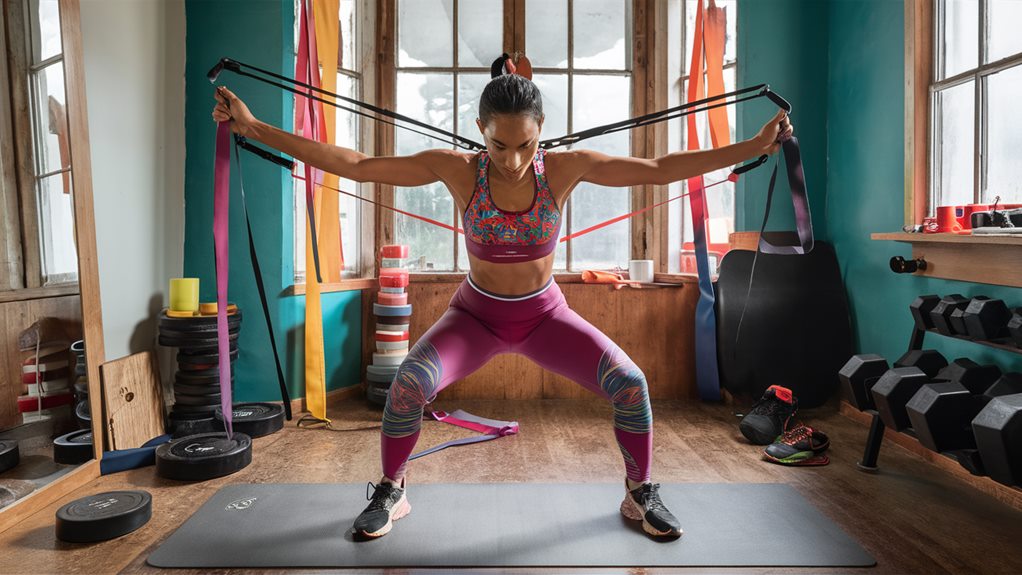
To effectively target different muscle groups with resistance bands, you need to understand how to tailor your workouts. Resistance bands are versatile tools that can help you achieve muscle activation and muscle isolation, allowing you to sculpt your body right at home. Choosing the right resistance levels is essential for maximizing your workout effectiveness.
Start by identifying the muscle groups you want to focus on. For example, if you're aiming to strengthen your biceps, use the band for bicep curls. Stand on the band with both feet and pull the handles up towards your shoulders, ensuring you control the movement. This method promotes muscle activation in your biceps, enhancing strength and endurance.
Next, consider isolating your muscles for more targeted training. For your triceps, try overhead extensions. Secure the band under your feet, grasp the handles, and lift your arms above your head while keeping your elbows close to your ears. This exercise specifically isolates the triceps, allowing for effective muscle isolation.
Don't forget about your legs! With squats, you can engage multiple muscle groups simultaneously. Loop the band around your thighs and squat down, feeling the resistance as you rise back up. This not only activates your quads but also engages your glutes and hamstrings.
Incorporating Resistance Bands Into Your Routine
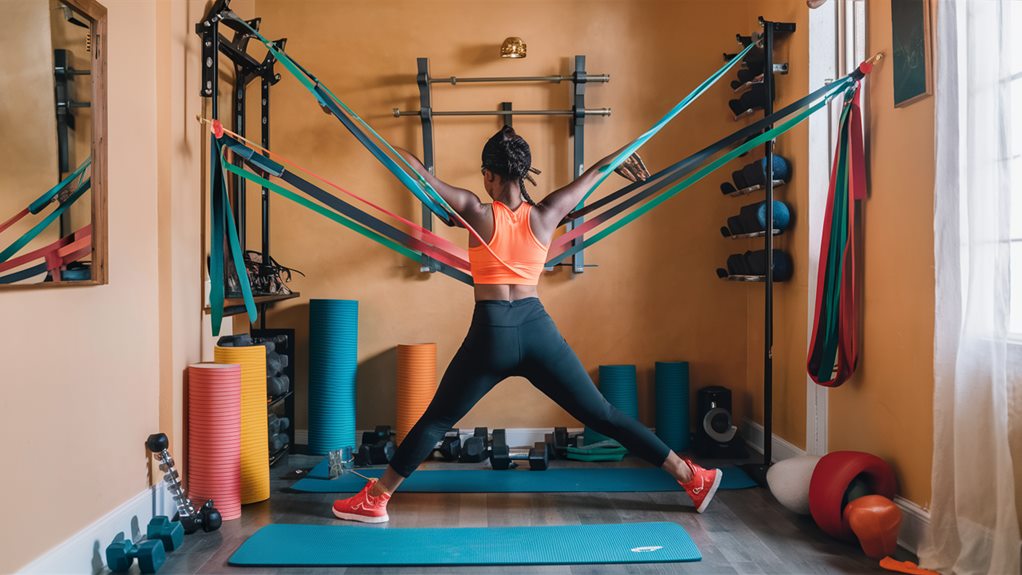
Integrating resistance bands into your routine can elevate your fitness game by adding variety and challenge to your workouts. These versatile tools are perfect for all fitness levels and can easily be adapted to suit your needs. By focusing on resistance band placement and making appropriate resistance band modifications, you can target different muscle groups effectively and keep your sessions engaging.
Here are some tips to help you incorporate resistance bands seamlessly into your routine:
- Start with a warm-up: Activate your muscles with dynamic stretches using bands to prepare for your workout.
- Mix up your exercises: Combine resistance band exercises with bodyweight movements for a well-rounded session.
- Adjust band tension: Use different bands or modify the placement to increase or decrease resistance as needed.
- Incorporate supersets: Pair resistance band exercises with traditional weights for enhanced intensity and muscle engagement.
- Cool down with stretching: Use bands to aid in flexibility and recovery after your workout.
Common Mistakes to Avoid
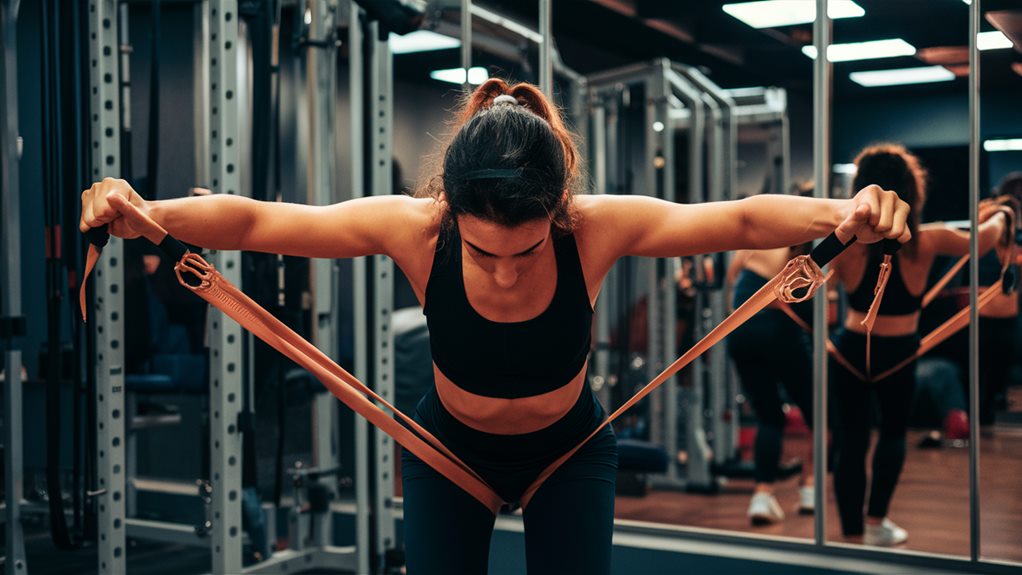
When using resistance bands at home, many people unknowingly make mistakes that can hinder their progress or lead to injury. One common error is using bands that are too light or too heavy. Choosing the right resistance level is essential for maximizing results. If the band is too light, you won't challenge your muscles enough; if it's too heavy, you risk compromising your form, which can lead to injury.
Another mistake to avoid is improper positioning. Make sure your body is aligned correctly during exercises. Poor posture can diminish the effectiveness of your workout and increase the chance of injury. Always engage your core and keep your back straight.
Additionally, don't rush through your movements. It's tempting to speed up to feel like you're accomplishing more, but slow, controlled movements are key for both avoiding injury and maximizing results. Focus on the muscle you're working and aim for quality over quantity.
Progressing Your Workouts Over Time

Progressing your workouts over time is crucial for continued improvement and to keep your fitness journey engaging. As you become more comfortable with resistance bands, it's crucial to challenge yourself to avoid hitting a plateau. Here are some effective strategies for progressing your workouts:
- Increase resistance: Use thicker bands or double up bands to add more challenge.
- Add more reps or sets: Gradually increase the number of repetitions or sets you perform.
- Adjust intensity: Modify your exercises to incorporate more complex movements that require greater strength and stability.
- Vary your routine: Change up your exercises to target different muscle groups and keep things interesting.
- Monitor progress: Keep a workout journal or use an app to track your improvements, like strength gains or endurance.
By focusing on these strategies, you'll be able to maintain motivation and create a sense of accomplishment. Monitoring progress not only helps you see how far you've come but also gives you the necessary feedback to adjust your intensity. Remember, it's perfectly normal to feel challenged, and embracing this discomfort is part of the growth process.
Engage with a community, whether online or in-person, to share your journey and gain inspiration from others. You're not alone in this, and together, you can celebrate victories, big and small. So, keep pushing forward—your dedication will pay off!
Frequently Asked Questions
Can Resistance Bands Replace Free Weights in My Workout Routine?
Absolutely, resistance bands can be great weight room alternatives in your workout routine! They offer versatile equipment comparisons, allowing you to target various muscle groups just like free weights. Plus, bands are portable and often safer, reducing the risk of injury.
How Do I Clean and Maintain My Resistance Bands?
To clean and maintain your resistance bands, start with some simple cleaning tips: wipe them down after each use with a damp cloth to remove sweat and dirt.
For deeper cleaning, use mild soap and water, then air dry completely.
As for storage solutions, keep them in a cool, dry place away from direct sunlight to prevent damage.
Taking these steps guarantees your bands last longer and support your fitness journey effectively.
Are There Any Safety Precautions When Using Resistance Bands?
When using resistance bands, it's important to prioritize safety. Always maintain proper form to avoid strain and maximize effectiveness. Start with a lighter resistance to gauge your strength and prevent injury.
Inspect your bands regularly for wear and tear; damaged bands can snap and lead to injury. Remember, injury prevention is essential to achieving your fitness goals. Stay focused, listen to your body, and enjoy the journey of getting stronger together!
Can Children Use Resistance Bands for Exercise?
You might think resistance bands are only for adults, but kids can benefit too! When used correctly, they can engage children in fun, child-friendly exercises that promote fitness. Just remember, children's safety is essential. Supervise their workouts, ensuring the bands are the right strength and size.
What Should I Look for in a Resistance Band Storage Solution?
When choosing a resistance band storage solution, focus on band organization and portability. Look for options that keep your bands tangle-free and easily accessible, making your workouts more convenient. Confirm the storage solution is durable enough to withstand regular use and offers a simple way to transport your bands.
A well-organized setup not only enhances your exercise routine but also helps you feel a sense of belonging in your fitness journey.
Conclusion
Using resistance bands at home can transform your workouts, offering both challenge and versatility. While you might find them lightweight, they pack a punch in building strength. Remember, proper technique is key to avoiding injury, but don't shy away from pushing your limits. As you progress, you'll discover new ways to target different muscle groups. Embrace the journey, stay consistent, and watch your fitness flourish—what starts as a simple band can lead to a stronger, healthier you.

